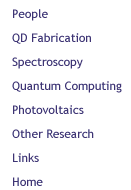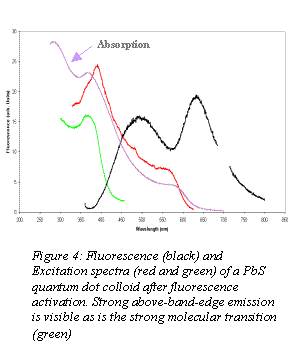|
|
The
University of Queensland
|

Bulk Quantum Dot Spectroscopy
Successful fluorescence activation of PbS quantum dots has for the first time enabled their optical characterisation. Spectrally resolved fluorescence and fluorescence excitation scans have been conducted on a wide variety of activated quantum dot solutions, revealing some remarkable and hitherto unseen features: All solutions exhibited strong fluorescence from above the PbS quantum dot band-edge. Such above-band-edge emission has never been observed in a semiconductor before. Furthermore, the fluorescence from above the band-edge behaved in a manner quite unlike either PbS or CdS, appearing to "switch on" abruptly when pumped with wavelengths shorter than 390 nm.
| The results obtained with activated lead sulfide illustrate the rather unique quantum properties of PbS quantum dots. In the fluorescence-activated samples, much of the above-band-edge emission is due to emission from the CdS nano-crystallites that have grown on suitable PbS surfaces. Fluorescence excitation spectra of both PbS and CdS quantum dots indicate a near coincidence of one particular intrinsic energy level. |  |
Single Dot Spectroscopy
Further characterisation of the quantum dots requires the capability to observe a single quantum dot via its fluorescence emission. High quality films of varying quantum dot concentration are produced to be examinied under the microscope. At present, both direct fluorescent imaging and two-photon fluorescence imaging are being conducted using a confocal microscope system and an ultra-fast laser system.
An imaging spectrometer is used along with a state-of-the-art liquid nitrogen cooled CCD detector and will be used for the single quantum dot detection. The confocal microscope system is presently being modified for these measurements and is expected to be working late in 2001.
Coherent time resolved diagnostics of the quantum dot molecules is planned using the Mira 900 femtosecond laser system. This requires the construction of a phase-locked Michelson interferometer, which is presently being designed and will be constructed late in 2001. The coherent pump-probe experiments represent a form of wavepacket interferometry which can be used to determine decoherence times as well as prepare specific quantum states of a system, including special entangled states.
Further research in this area, including work with doped quantum dots, spin properties of quantum dots and new means of coupling quantum dots are being explored.
Optical Readout of Spin States of Phosphorus
An alternative means of electron spin readout of the Kane computer using optical techniques has been undertaken in collaboration with Dr Daniel James of Los Alamos National Laboratory. The restrictive spectroscopy of phosphorus donors in silicon rule out any direct means of optical readout, however a most promising path remains, which is spin selective ionisation of the phosphorus donor atom and subsequent detection of the ion. The spectroscopy of the phosphorus indicates that it may be possible to accurately select which spin state is ionised, leaving the other bound to the phosphorus donor. Spectroscopic spin selection has the advantage that the exact spin state of the phosphorus bound electron can be determined which would allow spin initialisation of the quantum computer to be performed as well as spin readout.
 |